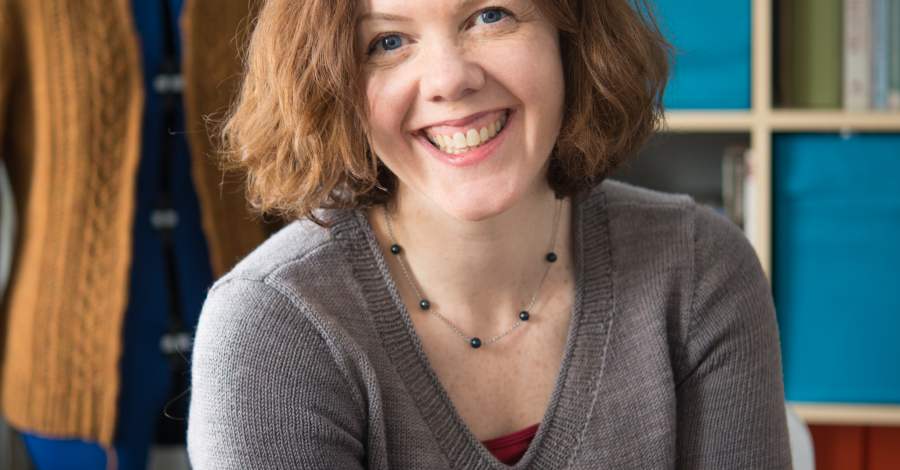We spoke with Amy Herzog for our feature on knitting for your body shape in our latest issue of Let’s Knit (Issue 70, September 2013). As always, she was so insightful we had to share with you her interview Q&A session with Kerry Knight Maher.
Women are renowned for being unhappy with their body shape, your book requires them to embrace their shape through discovering whether they’re ‘proportional’, ‘top-heavy’ or ‘bottom-heavy’, do you have any advice for helping these women to be proud of their shape?
This is such an important question, and I wish I had an answer sure to help every reader. The truth is, of course, that all of our shapes are perfectly lovely… ...and another truth is that hearing someone else say that typically doesn’t change our own internal voices. My best advice is actually to step in front of the camera more often. Seeing many, many pictures of myself finally allowed me to let go of my body-shape-demons, and I know it has worked for many other women I’ve connected with through my classes and book, too. There’s nothing like seeing yourself the way others see you—and that’s beautiful!
How would you recommend, for new and established knitters alike, to build their confidence when modifying patterns to suit their body shape?
I’d start by choosing a pattern that looks a lot like something you’d pick up in a shop and wear incessantly. Then, to ensure it fits you well, take the all-important step of choosing a size that fits your shoulders well. A sweater with ill-fitting shoulders will always, always look ill-fitting. Build your experience from there!
Do you have a particular philosophy on how to create flattering knitted garments?
I think flattering garments are ones that we love wearing. I’m definitely not out to dictate a certain style or shape to anyone! We all look our best in clothing that we love, and our hand-knit garments are clothing, after all. That said, if you don’t know what you’d like, perhaps begin with a pattern that balances out (or preserves the balance of) your figure and contains some of your favourite elements from your closet.
Can you give our readers a general list of the different modifications and rating them as easy, intermediate or advanced?
Easy modifications affect very few other pieces and require little calculation: Changes to the body and/or sleeve length, dropping or raising a neckline, moving waist shaping from the side seams toward the middle of your garment.
Intermediate modifications: Changing the rate of waist shaping, altering a neckline’s width, adding in bust darts. None of these are super-difficult, but they do require a bit of arithmetic.
Advanced modifications: Altering the width of a bicep, armhole shaping, armhole depth, and major row gauge changes. These all affect the single hardest bit of a pattern to modify, the sleeve cap. (Though honestly, it’s not that bad!)
What features of a garment would you recommend as a way of flattering the three types of shapes you list in your book?
Top-heavy shapes tend to look great in sweaters that narrow the shoulders and draw the eye down to the leg. Open-style cardigans with longer lengths, long sleeves (with a slight bell, even!), and narrow, deep necklines all look phenomenal.
Bottom-heavy shapes tend to look great in sweaters that broaden and call attention to their shoulders, with plainer hems. Yoked sweaters, wide collars, boat necks, and shorter sleeves are all wonderful choices.
Proportional shapes look best in sweaters that are themselves balanced. Broad neckline? Pair it with long sleeves and a slightly longer length! Narrow neckline? Keep the bottom simple, too.
If you could only impart one piece of wisdom to a new knitter, what would it be and why?
Your body is never, ever wrong. If something doesn’t work? It’s the pattern’s fault, not your body’s.

For more from Amy Herzog, go to www.amyherzogdesigns.com
Not only does she have a wonderfully honest blog, but she’s also a tutor at www.craftsy.com and has her book, Knit to Flatter (RRP £15.99, Stewart Tabori & Chang).



_333_180_c1.png)


_Craftihive_Let_s_Knit_Website_Blog_-_7.9.25_HEADER_IMAGE-01__333_180_64_c1.jpg)

_333_180_64_c1.jpg)
 Baby
Baby
 Toys
Toys
 Garments
Garments
 Crochet
Crochet
 Homewares
Homewares
 Dolls
Dolls



Share